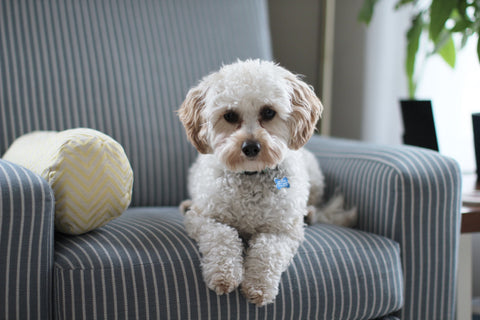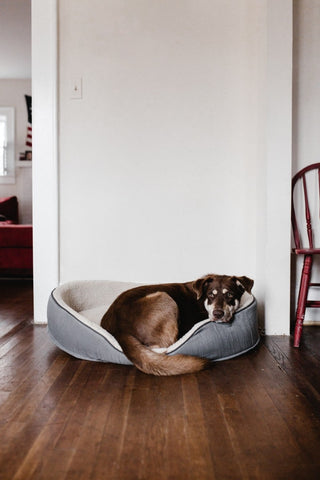They say a dog is man’s best friend. For our dogs, they feel the same way. We are their best friend. Your best friend deserves not only the best embroidered dog collar and leashes but the best training as well. If your dog is like mine, she had terrible anxiety when I left the house. Dog ID Collar.com has some tips on how to calm an anxious dog. No matter where I was going, she acted as if it may be the last time she would ever get to see me. However, there are a good many ways to cure this kind of isolation (separation anxiety) in your dog. The program listed here can help to prevent the condition.

How to Calm an Anxious Dog Without the Program
Along with the ten step program discussed below, there are other ways on how to deal with dog separation anxiety and they include:
- Exercise is the biggest key. Be sure to give your dog plenty of exercise before you leave the house. A happy (yet tired) dog will have much less energy and be less anxious as you leave. Allow for about 30 minutes of exercise time and a few minutes for your dog to calm down and start relaxing.
- Give your dog one of his favorite toys about five minutes before you leave. This will help to divert his attention as you slip out the door.
- Calm is the word. As you leave (and as your return), be as calm as possible, showing little emotion. Avoid the hugs and kisses and telling him how much “daddy loves you.” If your dog gets too excited and jumps up, do your best to ignore it. It’s even best to turn around, walk away, and ignore the behavior. Once your dog has settled down, then offer a friendly (but calm) hello.
- Show your dog a few of the components of your leaving routine even when you are NOT leaving. Let him see you gather your belongings, but then sit down and watch T.V. Grab your keys, but then make the bed. Set your alarm to go off in the morning, but then roll over and go back to sleep. Defuse his understanding of association.
- Mix the pieces of your leaving routine each time, so his behavior doesn’t swell to a frantic level when he realizes you are about to go. Just like humans, dogs are creatures of their own habits. So, as is the inverse of the previous tip, eat breakfast when you come home. Pick up your car keys, but then take him outside for a walk. Put your belongings in the car, while staying in your pajamas. All these actions that may seem “little” are great tips on how to calm an anxious dog.
- Only say “I’ll be back,” when you are certain you’ll actually be returning in a short period of time - a period of time that your dog is used to tolerating. This will help your dog to relax and trust your words.
- Explore the idea of employing a pet daycare or a neighbor who might enjoy spending time with your dog. Once your dog is comfortable in their new environment, this is a great way for how to calm an anxious dog.
- Try a Comfort Zone plug-in in his environment to help with his fear.
- Remove all the things that cause your dog stress while you are away. Put them out of sight. This includes alarms, noisy devices, and especially shock collars.
- You may want to hire a dog behavior specialist so that you are modifying your dog’s behavior correctly.
It isn’t easy fixing separation anxiety in a dog which is why Dog ID Collar.com has put together a program on how to calm an anxious dog. Be ready to get frustrated and think it will never work. Your dog will panic and have setbacks. He honestly is worried about his own survival without you in his life. You and he are a pack. He protects you and you protect him. When you are gone, it is worrisome and troubling for him. However, if you are committed to changing your dog’s behavior, in helping him trust you, be brave about spending time alone, he will enjoy family life with you so much more.
put together a program on how to calm an anxious dog. Be ready to get frustrated and think it will never work. Your dog will panic and have setbacks. He honestly is worried about his own survival without you in his life. You and he are a pack. He protects you and you protect him. When you are gone, it is worrisome and troubling for him. However, if you are committed to changing your dog’s behavior, in helping him trust you, be brave about spending time alone, he will enjoy family life with you so much more.
Ten Steps on How to Calm an Anxious Dog
Setting your pet up for success is the number one ingredient for a successful behavior modification program. Hopefully, you are able to start this process when he is a puppy, where the steps can be done gradually and while they are just learning what a routine with you actually looks and feels like. If you can teach a dog to believe that you’ll never abandon them, it makes it so much easier.
So we offer these 10 steps of a program (designed to last two days) which will assist with your dog being comfortable when left alone.
- Bring your dog to his new home when you are able to spend a few days uninterrupted. This will help him ease into the new situation and environment. This is a big transition, so give him some quality time.
- Prepare his space before he even gets there. Be sure it is quiet, safe and dog-proofed. A playpen or laundry room works great.
- Your dog needs the opportunity to relieve himself outdoors when you get home, then spend fifteen minutes or so with him under supervision. After this, let him go into his pen while you stay with him in the same room.
- Remain nearby, and if he begins to fuss, ignore it. Check your phone or something, but don’t engage and don’t leave his sight. Then when he is quiet, say hello to him calmly, take a step back, then return before he gets upset. Speak calmly, then go back to the newspaper. You’re showing him that you will come back. When learning how to calm an anxious dog, consistency is key.
- Continue this practice of stepping away, then increasing the distance and varying the amount of time away. The goal is for you to wander the room without your dog becoming agitated. Each time you come back, calmly greet him again. Praise him by saying “Yes!” but do it calmly and cheerfully. Then walk away. Then return again. This is a good time for a treat, but not for excitement.
- Give your dog a break after about an hour. Allow him to potty and play outside. Then it’s fine to go back inside and practice some more.
- Round two. Start the entire process over. Stay near his pen until he has settled. Be quicker and more deliberate with your movement now. Go further away and stay away longer. Just be sure to return before he gets upset. Now go to a completely different room, out of sight - but only for a brief moment or two. Now sit with him again and go back checking your emails. Again, he is seeing you leave and return, leave and return. If your dog is agitated during this practice, move a good distance away and wait for him to stop before proceeding. In addition to showing him you’ll come back, you want him to know it will only happen when he is calm.
- Get ready for an even bigger challenge. Step completely outside of your house. The goal for this first day is to get him comfortable with you leaving for only about twenty minutes. Training has shown that his first twenty minutes alone are the hardest. Be sure to vary the amount of time away, or else he will learn to anticipate the return. Your dog is smart, so while you’re learning how to calm an anxious dog, he’s learning too. Remember, plenty of play and potty opportunities are crucial to his success.
- Day number two. Do a quick review with your dog, repeating the preliminary steps from day one. Today, while taking a potty break, jump into your car and drive around the block. Don’t be gone long. Return in five minutes, then calmly enter the house and resume the practice. In a couple of hours, do it again. Remember what he’s learning. “Wow, my human really does come back.”
- Let’s try a Sunday morning away. Give your dog some quality play and potty break time for about fifteen minutes. Then allow for a few minutes of calm relaxation. Give him a toy, then calmly leave the house for a few hours. Go to brunch and don’t worry. An uneventful return with no excitement is the goal.

Dog ID Collar.com wishes you happy training on how to calm an anxious dog. Our dogs are like kids, really. Establish the routine. Let them learn to trust you. Show your love calmly. His devotion will grow and you will both have a great, long-lasting relationship.
